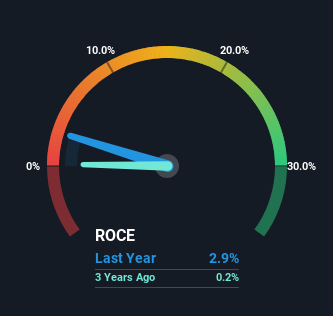- China
- /
- Oil and Gas
- /
- SHSE:600617
Shanxi Guoxin Energy's (SHSE:600617) Returns On Capital Not Reflecting Well On The Business

If you're looking at a mature business that's past the growth phase, what are some of the underlying trends that pop up? More often than not, we'll see a declining return on capital employed (ROCE) and a declining amount of capital employed. Trends like this ultimately mean the business is reducing its investments and also earning less on what it has invested. So after glancing at the trends within Shanxi Guoxin Energy (SHSE:600617), we weren't too hopeful.
Understanding Return On Capital Employed (ROCE)
Just to clarify if you're unsure, ROCE is a metric for evaluating how much pre-tax income (in percentage terms) a company earns on the capital invested in its business. To calculate this metric for Shanxi Guoxin Energy, this is the formula:
Return on Capital Employed = Earnings Before Interest and Tax (EBIT) ÷ (Total Assets - Current Liabilities)
0.029 = CN¥507m ÷ (CN¥29b - CN¥12b) (Based on the trailing twelve months to September 2023).
Thus, Shanxi Guoxin Energy has an ROCE of 2.9%. Ultimately, that's a low return and it under-performs the Oil and Gas industry average of 12%.
See our latest analysis for Shanxi Guoxin Energy

Historical performance is a great place to start when researching a stock so above you can see the gauge for Shanxi Guoxin Energy's ROCE against it's prior returns. If you'd like to look at how Shanxi Guoxin Energy has performed in the past in other metrics, you can view this free graph of Shanxi Guoxin Energy's past earnings, revenue and cash flow.
What Can We Tell From Shanxi Guoxin Energy's ROCE Trend?
There is reason to be cautious about Shanxi Guoxin Energy, given the returns are trending downwards. To be more specific, the ROCE was 3.7% five years ago, but since then it has dropped noticeably. And on the capital employed front, the business is utilizing roughly the same amount of capital as it was back then. Since returns are falling and the business has the same amount of assets employed, this can suggest it's a mature business that hasn't had much growth in the last five years. If these trends continue, we wouldn't expect Shanxi Guoxin Energy to turn into a multi-bagger.
On a side note, Shanxi Guoxin Energy's current liabilities are still rather high at 40% of total assets. This can bring about some risks because the company is basically operating with a rather large reliance on its suppliers or other sorts of short-term creditors. Ideally we'd like to see this reduce as that would mean fewer obligations bearing risks.
The Key Takeaway
In summary, it's unfortunate that Shanxi Guoxin Energy is generating lower returns from the same amount of capital. Long term shareholders who've owned the stock over the last five years have experienced a 48% depreciation in their investment, so it appears the market might not like these trends either. That being the case, unless the underlying trends revert to a more positive trajectory, we'd consider looking elsewhere.
Shanxi Guoxin Energy does come with some risks though, we found 2 warning signs in our investment analysis, and 1 of those doesn't sit too well with us...
While Shanxi Guoxin Energy may not currently earn the highest returns, we've compiled a list of companies that currently earn more than 25% return on equity. Check out this free list here.
If you're looking to trade Shanxi Guoxin Energy, open an account with the lowest-cost platform trusted by professionals, Interactive Brokers.
With clients in over 200 countries and territories, and access to 160 markets, IBKR lets you trade stocks, options, futures, forex, bonds and funds from a single integrated account.
Enjoy no hidden fees, no account minimums, and FX conversion rates as low as 0.03%, far better than what most brokers offer.
Sponsored ContentNew: Manage All Your Stock Portfolios in One Place
We've created the ultimate portfolio companion for stock investors, and it's free.
• Connect an unlimited number of Portfolios and see your total in one currency
• Be alerted to new Warning Signs or Risks via email or mobile
• Track the Fair Value of your stocks
Have feedback on this article? Concerned about the content? Get in touch with us directly. Alternatively, email editorial-team (at) simplywallst.com.
This article by Simply Wall St is general in nature. We provide commentary based on historical data and analyst forecasts only using an unbiased methodology and our articles are not intended to be financial advice. It does not constitute a recommendation to buy or sell any stock, and does not take account of your objectives, or your financial situation. We aim to bring you long-term focused analysis driven by fundamental data. Note that our analysis may not factor in the latest price-sensitive company announcements or qualitative material. Simply Wall St has no position in any stocks mentioned.
About SHSE:600617
Shanxi Guoxin Energy
Engages natural gas development and utilization, and consulting services.
Good value with worrying balance sheet.
Market Insights
Community Narratives




